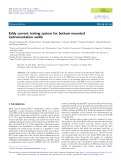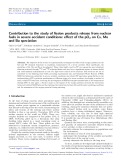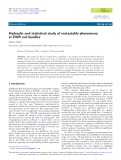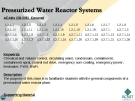
REGULAR ARTICLE
Hydraulic and statistical study of metastable phenomena
in PWR rod bundles
Florian Muller
*
CEA Saclay, DEN/DANS/DM2S/STMF/LMSF, 91191 Gif-sur-Yvette, France
Received: 30 October 2019 / Accepted: 15 November 2019
Abstract. The analysis of fuel rod bundle flows constitutes a key element of Pressurized-Water Reactors
(PWR) safety studies. The present work aims at improving our understanding of nefarious reorganisation
phenomena observed by numerous studies in the flow large-scale structures. 3D simulations allowed identifying
two distinct reorganisations consisting in a sign change for either a transverse velocity in rod-to-rod gaps or for a
subchannel vortex. A Taylor “frozen turbulence”hypothesis was adopted to model the evolution of large-scale
3D structures as transported-2D. A statistical method was applied to the 2D field to determine its
thermodynamically stable states through an optimization problem. Similarities were obtained between the
PWR coherent structures and the stable states in a simplified 2D geometry. Further, 2D simulations allowed
identifying two possible flow bifurcations, each related to one of the reorganisations observed in 3D simulations,
laying the foundations for a physical explanation of this phenomenon.
1 Introduction
Insufficient flow thermal mixing in the rod bundles within a
Pressurized-Water Reactor (PWR) can lead to a boiling
crisis, which is nefarious for the reactor operational safety.
Mixing grids are typically used to enhance the thermal
mixing inside fuel arrays, mostly through the intensifica-
tion of the secondary flows. These secondary flows have a
tendency to organize into large-scale structures in the plane
normal to the tube axes. Numerous experimental or
numerical studies have shown the existence of reorganisa-
tion phenomena in the transverse flow large-scale struc-
tures (see the review in appendix A from Kang and Hassan
[1]). In particular, the AGATE experimental results [2]
featured a global 90°rotation of the cross-flow pattern
between the near and the far wake of a mixing grid. This
reorganisation is shown in Figure 1: a sketch of a 5 5 rod
bundle fitted with a mixing grid, as well as colour plots of
the transverse flow downstream a mixing grid are shown.
The cross-flow is aligned with a 45°angle in the first one,
but has rotated by 90°in the second one.
Such reorganisations are very significant for reactor
safety studies: due to the points with zero cross-flow they
induce, they lead to drops in the thermal mixing as
demonstrated by Shen et al. [3], which can pose a serious
risk to the PWR reactor operational safety. This work
aimed at improving our understanding of these phenomena,
both for enhancing their characterization and for identifying
their origin, with the long-term goal of developing small-scales
models suited for this type of flow.
Little concrete information can be found in the
literature on the reorganisation phenomenon. This is due
to the lack of high-quality experiment where the
phenomenon typically occurs, and to the fact that, among
the variety of Computational-Fluid Dynamics (CFD)
numerical simulations performed for rod bundle flows,
few were conducted for the entire rod bundle axial span and
with high-fidelity turbulence models. Attempting a new
method, we focused on a physical approach to the
reorganisation phenomenon by proposing an original
method for the study of the rod bundle flow. A similarity
was noticed between PWR rod bundle flow reorganisations
and some phenomena typically experienced by quasi-2D
geophysical flows, such as the Jupiter Red Spot or the Gulf
Stream [4]. Indeed, the latter sometimes display important
changes in their structure, leading to oscillations between
very distinct solutions. These phenomena can be inter-
preted as phase transitions between different equilibrium
states which become metastable.
In order to study the reorganisation phenomena from
the perspective of this similarity with 2D flows, the following
steps were taken. 3D simulations were first performed in
order to decompose the large-scale reorganisations into
local inversions, and to justify a Taylor “frozen turbulence”
hypothesis, as described in Section 2.Section 3 details the
2D statistical method that was applied in simplified
geometries with obstacles based on this hypothesis. The
*e-mail: florian.muller99@gmail.com
EPJ Nuclear Sci. Technol. 6, 6 (2020)
©F. Muller, published by EDP Sciences, 2020
https://doi.org/10.1051/epjn/2019057
Nuclear
Sciences
& Technologies
Available online at:
https://www.epj-n.org
This is an Open Access article distributed under the terms of the Creative Commons Attribution License (https://creativecommons.org/licenses/by/4.0),
which permits unrestricted use, distribution, and reproduction in any medium, provided the original work is properly cited.
























